The Lenovo ThinkPad T450s Review: Bridging The Ultrabook
by Brett Howse on September 15, 2015 8:00 AM ESTDisplay
The review unit that arrived came with an upgraded display. Lenovo offers a 1600x900 panel, but for not very much more you can outfit the device with a 1920x1080 IPS panel. This is going to be a significant upgrade since the 1600x900 version is not IPS, and should therefore be avoided if at all possible. On the configuration page, Lenovo is charging just $60 to upgrade to the better panel which is a good enough deal that I have to question why they even offer the other one at all, but I’m sure there are very price conscious buyers out there. What is not quite as good of an upgrade offer is the $235 upgrade ($175 over the standard 1080p offering) for 1920x1080 with touch which is a lot to pay for touch, and considering the ThinkPad T450s is not a convertible notebook, it’s really not needed.
Because of a resolution that is fairly standard, there is no need for any sort of funky subpixel arrangement on the panel which is a good thing. Lenovo also has an anti-glare coating even on the touch model. The exact panel model is not known because of the way Lenovo overwrites the string, but it has good viewing angles, and consistent lighting levels on the display without any obvious signs of backlight leakage.
To test for color accuracy and display performance, we use SpectraCal’s CalMAN 5 suite with a custom workflow. Brightness and contrast readings are done with an X-Rite i1 DisplayPro colorimeter, and color accuracy is tested with an X-Rite i1Pro Spectrophotometer. Lenovo is one of the few companies that actually includes a default icc profile, so the display was tested with that profile set as active. Displays are tested at 200 nits.
Brightness and Contrast

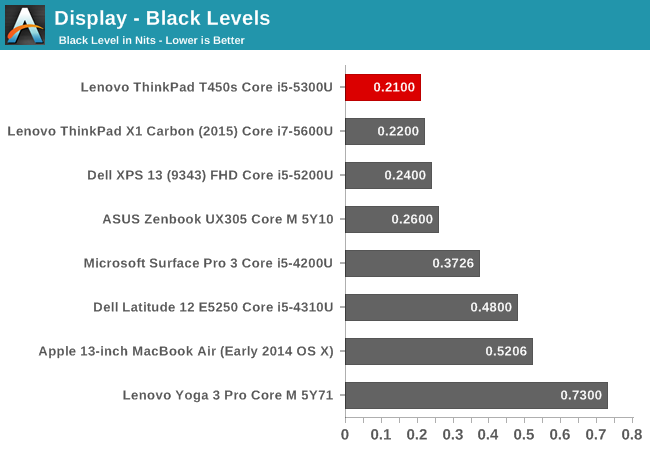

The overall panel does not get very bright. At just 265 nits, it is on the lower end of the scale. This is not great for use outdoors, although the anti-glare coating should help this somewhat. The black levels though are very good, resulting in an excellent contrast ratio of 1263:1. For those that need to or want to work in very dark environments, the T450s has a display that goes all the way down to 2.2 nits output which is perhaps too extreme, but it should be no problem to find a level that is suitable for a dark environment.
Grayscale and White Point
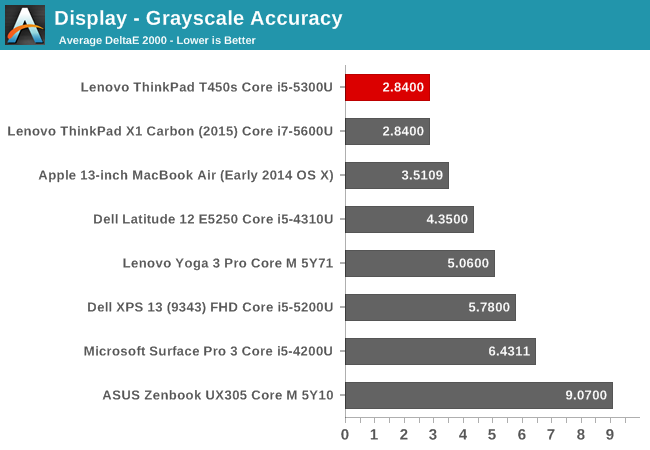
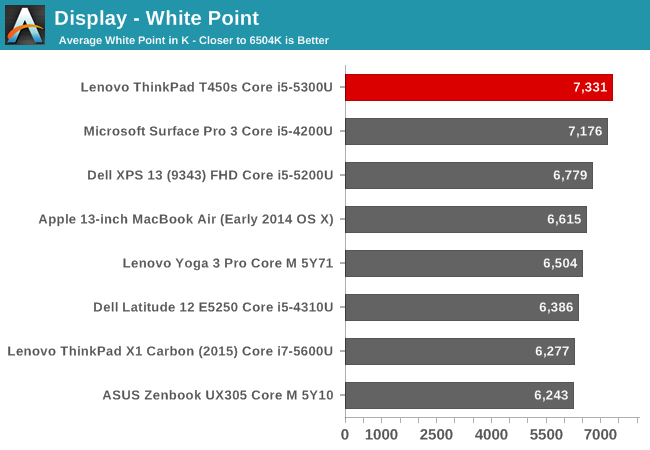
Looking at the grayscale, we see an overall average that is under 3, which is a great result. The grayscale does creep up though higher in the range, and full white is closer to an error level of 5 which could be better. On the whole though the grayscale is quite good and the gamma is also decent, coming in at an average of 2.2. The display is a bit cool though, with the reds dropping off as the output gets higher.
Saturation Accuracy

Saturations are once again very good, with an overall average error of just 2.2. Values under 3 are considered a good result in this test, and the T450s does very well. Even at 100% saturation the values are all very close to correct, and CalMAN shows that this display can do 96% of the sRGB color space.
Gretag MacBeth
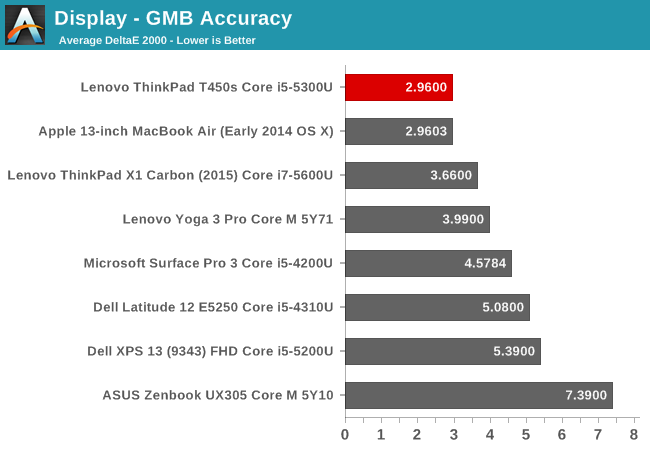
The Gretag MacBeth colorchecker is the most comprehensive test, and it scores once again under 3 which is a good result. There is certainly some drift especially on magenta, but overall this is a well calibrated display with an icc profile which helps keep the grayscale in check.
Relative Color Comparator
This is something that we are bringing back to our display testing. The images show a relative color comparison between what the display is supposed to produce and what it actually does. You can see that there is certainly some blue in the whites due to the cool color temperature, but the colors themselves are very close to correct. Please remember that any inaccuracies in your own display will shift these results, so do not take them as absolute values but as relative results.
Display conclusion
Generally the testing would conclude with creating an icc profile and trying to get better results, but there is little need with the T450s. It already has an icc profile which really only helps out grayscale unless you have a 3D LUT which most notebooks lack. The T450s is an overall excellent display and really only has an issue with overall display brightness. If Lenovo could squeeze another 100 nits out of the panel, it would be right up there with the top displays. Just remember to avoid the base 1600x900 panel.


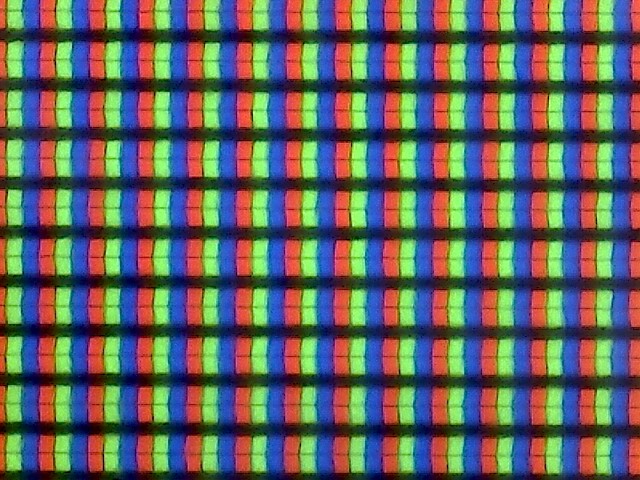













108 Comments
View All Comments
Flunk - Tuesday, September 15, 2015 - link
I kinda wish it was available with Iris Pro. I don't expect an Ultrabook to really be good at gaming but being able to play the occasional game would be nice.DanNeely - Tuesday, September 15, 2015 - link
Seeing this display used in a higher performing laptop would be nice; but a 47W processor isn't going to be usable in a chassis designed for a 15W one.fokka - Tuesday, September 15, 2015 - link
i think he means the normal iris, like some macbook air are using, i think it's the Uxx50 line. those have double the EUs, but lack the EDRAM of iris pro.DanNeely - Tuesday, September 15, 2015 - link
Haswell/Broadwell didn't use non-pro Iris nomenclature for anything below 28W; which would again be too hot for the current XPS13 chassis. Skylake is adding something called Iris 540 which has 48 EU and 64MB eDRAM and is available at a 15W TDP. It's possible Dell will include this as an option for the skylake refresh; I can't find any detailed rumors about it. Iris 550 (again not pro) is the same hardware at 28W. No skylake chips with Iris Pro are out yet; but since it's 72 EU and 64/128mb eDram; I suspect it'll be only at the 47W tdp again.I'm somewhat interested in the possibility of an Iris 540 version of the laptop too; assuming the bump in light gaming ability is reasonable for the increase in purchase price anyway. Progressively more bloated web pages are slowly pushing my oldschool atom powered laptop below the threshold of usability even for an occasional use machine; and a skylake XPS13 is currently the potential machine to beat for me.
extide - Wednesday, September 30, 2015 - link
You can get Iris Pro in 28W, and with Skylake there is "baby" Iris Pro (64MB) in 15Wretrospooty - Tuesday, September 15, 2015 - link
XPS are great... until they die. ... DEEELLLL!!!!mooninite - Tuesday, September 15, 2015 - link
The ASUS UX301LAA has been out for several years and has been unmatched. Iris graphics, hi-dpi screen, 2x256gb ssd m.2 drives, 5-6 hours typical battery but I've left the thing on (forgot about it) with the lid closed for up to 12 hours and it still had battery left.nerd1 - Wednesday, September 16, 2015 - link
I found HP spectre x360 to be better built, has more value, converts into tablet and only very slightly heavier (It's almost as light as macbook air)michael2k - Tuesday, September 15, 2015 - link
Doesn't the 12" MacBook use a similar display?Samus - Tuesday, September 15, 2015 - link
As hard as it is for many to consider Dell as a relevant brand (after years of making utter shit, circa 2003-2008) it's hard to ignore them now. Just get over your memories (like the Deskstar 75GXP days) and try a XPS13 out.The display isn't the only part of the machine that's in a class of its own, but the keyboard. They really "ripped-off" the old Thinkpad keyboard perfectly while still making a slim machine.
HP's keyboards are acceptable. At the end of the day, they're made by the same people who make Lenovo's keyboards (Chicony) while Dell's are made by Quanta/NSK Darfon, who for the mean time appears to be making the best Chiclet and floating-island style keyboard.